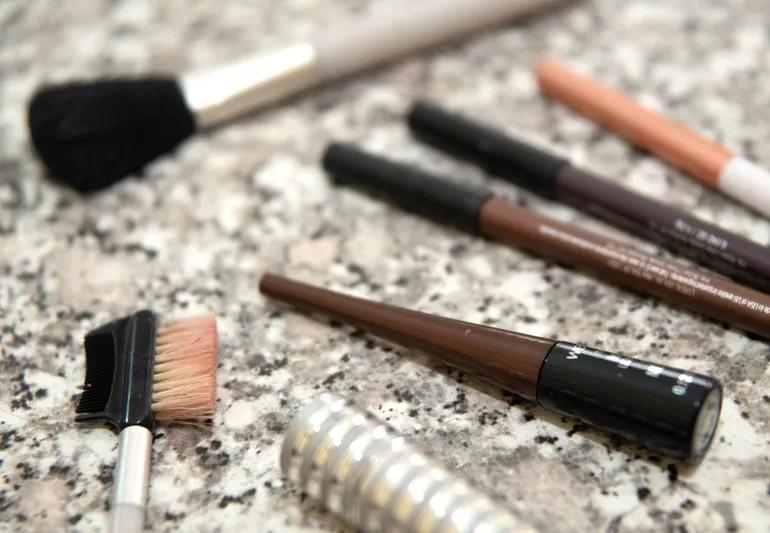Find out how to avoid infections and reactions from a skin care pro

It’s hard to part with your makeup, especially when you paid a pretty penny for it. If it still looks good and smells fine, can’t you just keep it?
Advertisement
Cleveland Clinic is a non-profit academic medical center. Advertising on our site helps support our mission. We do not endorse non-Cleveland Clinic products or services. Policy
Don’t do it, says dermatologist Shilpi Khetarpal, MD. She explains why makeup doesn’t get better with age — and when you need to give your products the heave-ho.
Yes, it does. If you’re wondering when to toss makeup, how soon makeup goes bad depends on a few factors:
Advertisement
Makeup expiration dates refer to an unopened product. Once you open it, the clock starts ticking. “Makeup contains preservatives, but they can’t fight off all the germs once you start using the product,” says Dr. Khetarpal.
And never share your makeup, no matter how badly your bestie wants to sample that amazing blush. You could be sharing an infection, cold sore or acne breakout.
So when should you toss the contents of your makeup bag? Each product has its own timeline.
Mascara is in close contact with your eyes. And the tube is moist and dark inside — a prime environment for bacteria and fungus. Your mascara wand could be an eye infection waiting to happen.
Always toss your mascara six months after opening it. But throw it out even sooner if:
“It’s tempting to buy that jumbo tube of mascara,” says Dr. Khetarpal. “But realistically, you won’t go through all that mascara in six months. Buy the travel size, so you don’t feel like you’re wasting as much when you throw it away.”
Finally, avoid pumping your mascara wand in and out of the tube of mascara, and don’t add water or anything else to mascara.
A dry eyeliner pencil isn’t quite as prone to bacteria and germs as mascara. But because it’s touching your eye area, you need to be careful with it.
You can use dry eyeliner pencils until they run out if you:
Toss liquid eyeliners after six months. You can’t wipe them with alcohol or sharpen them, and the higher water content invites germs in.
Expired face makeup can cause allergic reactions, acne and irritation.
“Makeup in a pump will last much longer than an ordinary bottle top,” says Dr. Khetarpal. “A pump keeps the contents from touching anything. If you use a liquid in a regular bottle, don’t put the sponge or your finger right on the opening. Instead, pour it on your sponge or hand.”
Texture changes are a bad sign. “If you see clear liquid on top, even if the product is unopened, throw it away,” says Dr. Khetarpal.
If you rely on your foundation for sun protection, treat it like sunscreen. Toss it six months after you open it. “If you’re using SPF foundation that’s over six months old, you’re not getting the full sun protection,” says Dr. Khetarpal. “Apply sunscreen first and then foundation. Then you can keep your foundation longer without worrying about its sun protection.”
Anything that’s not dry and powdery in texture has enough liquid to spoil within six months. Use the liquid foundation rules for these products:
Advertisement
You can keep powders for up to two years if you keep them clean. This includes powder-based blush, eye shadow and face powders. Their low water content means they’re less likely to grow mold and bacteria.
“Clean brushes or sponges at least weekly because they’re touching your powder and skin every time you use them,” says Dr. Khetarpal. “Use shampoo to wash them and allow them to air dry completely. Weekly washing minimizes the bacteria that builds up.”
But the SPF rule still applies: If powder is your only sun protection, toss it after six months. And if it gets a weird smell or texture, it has to go.
Lipsticks and balms are cream-based, and many of them have SPF in them. “Use these for six months tops,” says Dr. Khetarpal. “Our lips have a lot of bacteria on them, so these products get contaminated quickly.”
And if you get a cold sore, throw out all your lip products and start fresh.
It’s tempting to hold on to that perfect concealer that’s been discontinued, but it’s not worth the risk.
Advertisement
Learn more about our editorial process.
Advertisement

Moisturizing, running a humidifier and adjusting your showers may help keep itchiness and irritation at bay

Glycolic acid benefits skin tone, texture and pigmentation by exfoliating dead skin

Some gentle soap and warm water go a long way when you’re washing these cosmetic tools regularly

New formulas are less drying and contain water-based and skin-loving ingredients

At a minimum, in the morning, apply a cleanser, followed by a moisturizer and sunscreen, in that order

The convenient option is good for touch-ups, but it shouldn’t replace your traditional sunscreen

Olive oil works as a skin moisturizer, but it’s not right for everyone

Sunscreen, moisturizer and a topical antioxidant every day are a good start to a good skin care routine

Start having sex about 72 hours before ovulation, then at least every other day during your fertile window

Attachment theory suggests that your earliest relationships shape connections throughout your life

It isn’t a recognized mental health disorder, but research shows that problematic social media use can negatively affect your mental health, self-esteem and sleep